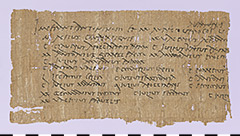BGU II 610 (P. 7428)
Latin Texts are quite rare on papyri. This papyrus is a nice example of this. It is inscribed on only one side and contains a list of veterans of a legion with names and rank designations. The text probably comes from the Faijum, belonged to the collection of the Egyptologist Heinrich Brugsch and became part of the Berlin Papyrus Collection in 1891.
The papyrus is almost completely preserved. Only on the right side it is broken off. A lot of letters are missing here. The Latin text is carefully written and runs across the fiber. All names are typically Roman and are given in the usual form, i.e. with praenomen, nomen, and cognomen, if fully preserved. The praenomen is always abbreviated, usually indicated by a point.
After a heading and a date the list itself is divided into two sections. Within these sections, the writer tried to write the names in columns below each other. At the end of the list, he did not succeed because of the much longer names.
The first section contains the higher ranks. The individual names of the Roman citizens are followed by their respective ranks they held in the army. Since these persons are now veterans, each rank designation was preceded by an ex-. For two people, the rank designations are lost on the right edge. From the others we learn that a M. Alfius Coma is a former signifer, i.e. he carried the standard of the century and was as such an important landmark during a battle. Usually, experienced soldiers were appointed signiferi, who had distinguished themselves by special bravery. In addition to the standard, the signifer were distinguished from other legionaries mainly by his special helmet, which could be closed with a mask and on which the head and fur of a predator was attached.
Three other persons are referred to as former imaginiferi, i.e. they carried the imperial portraits, which the legions carried along beside the standards. For a M. Antonius Gemellus it is stated that he is a former cornicularius. His rank designation is derived from a medal with two small horns, which he wore on his helmet. He was the head of the office, the manager of his century and took care of the archive and similar things.
The second section contains a list of common soldiers who have not been given any details besides their name.
Due to the dating formula in the second line, we can date this list exactly. Since under the Romans the acting consuls were eponymous for the current year, their consulate became the dating criterion. This is also the case in this text, in which it is stated that the Emperor Antoninus was consul for the third time and held this office together with M. Aurelius Verus. This is the year AD 140. Antoninus is the Roman Emperor Antoninus Pius, M. Aurelius Verus, his future successor Marcus Aurelius.
The document was written in Alexandria, as becomes clear from the first line, and probably comes from the office of the legio III Cyrenaica or the legio XXII Deiotariana – both legions were stationed in Egypt at that time. It is likely that this text is a list, as it was used by the governor who honorably dismissed the veterans from the military in the name of the Emperor after serving their term of service, or as was necessary for the tax collection. This papyrus shows how exactly the Roman Empire kept record over its citizens.



